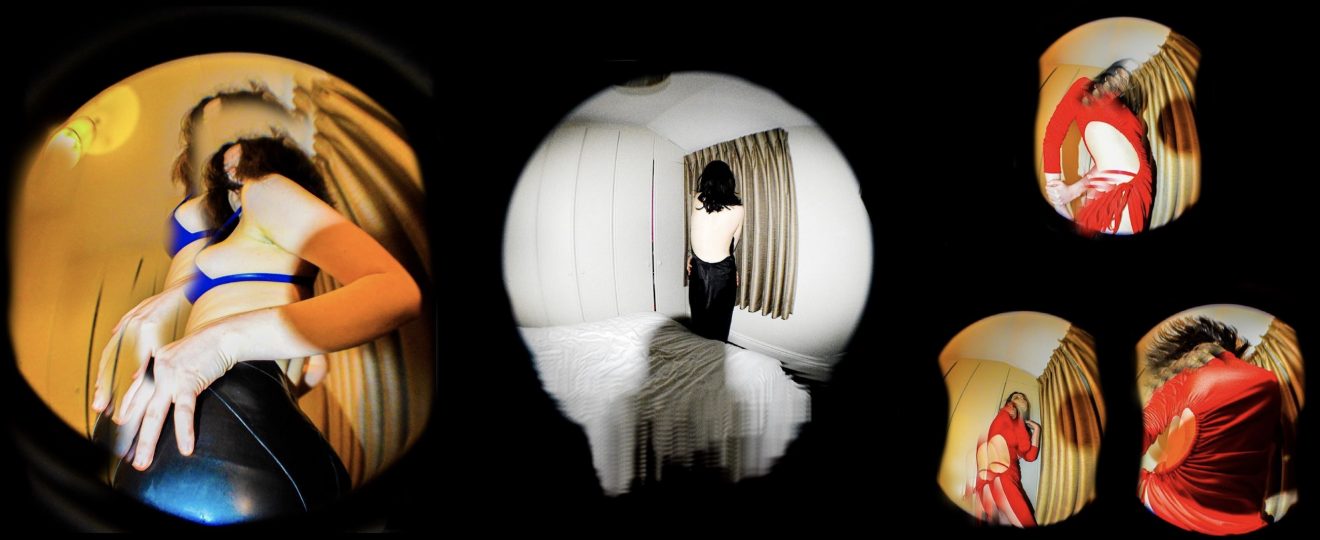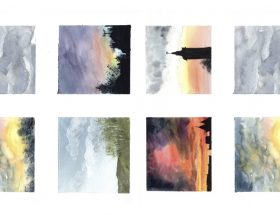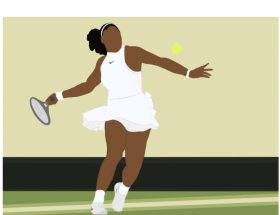On fashion, photography, art, and Ireland.
On my computer screen, Sínead Tomás is sitting in a clean and bright room on the edge of a bed, her dark hair draped sweetly over her shoulders, her energetic and twinkling voice affably armed with a warm smile. On my phone screen, however, she’s confined to the borders of a photograph, swimming in a sea of oversaturation, with garish strokes of red and harsh dashes of purple. Her face tilts up, teeth bared by a dental cheek redactor, arms above her head: she is mid thrash.
This sort of image is only one stylistic route of the many in Tomás’ artistic armory. A creator born in San Francisco to Irish parents, and a current student at Polimoda Fashion School in Florence, she says she has always exhibited a creative appetite: ‘I always really gravitated to being creative and expressing myself, and I have always found different ways of doing it.‘
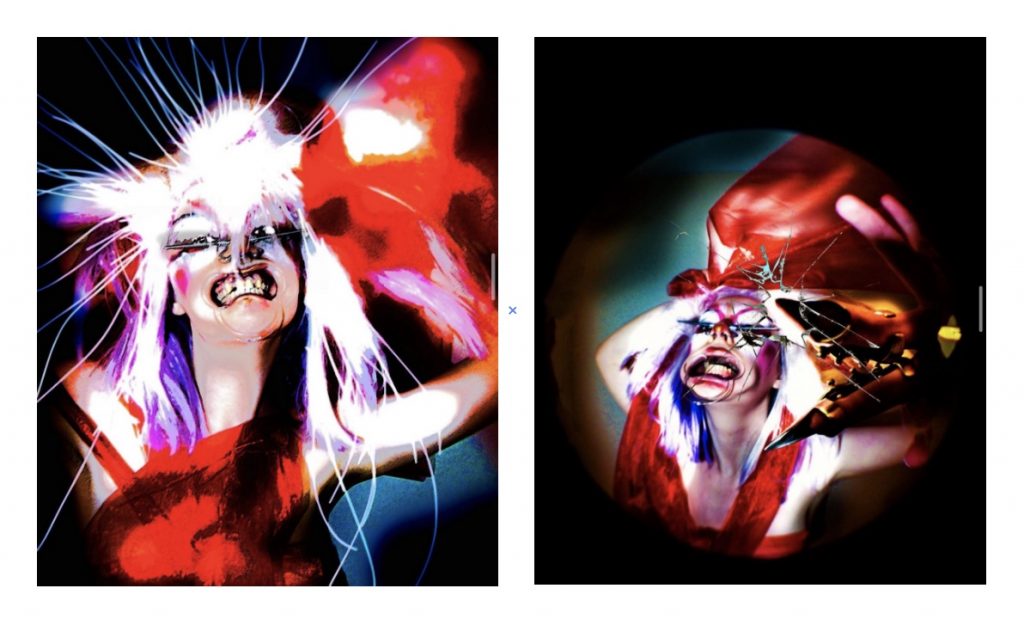
I first met Sínead when I was eleven years old on a school playground in Northern California. After following her work for a few years, we reunited for this interview in August of 2021. She answered my call while in Ireland, the country to which she headed following Covid’s initial cross-country emergence: ‘I quickly went to Ireland because that’s where my family was. I thought it was going to be a three-week thing but ended up staying a year and a half. Most of the artistic work I have been doing has been from this Airbnb. Everything has been made with bedsheets, photoshop, wigs, all in an effort to try to keep myself entertained and sane.‘
In our conversation, I was not just amazed by how much we had both aged since we had last spoken, but by Tomás’ zeal for her artistic work, her assiduous approach to creation, and the loveliness of her general disposition. Having posted her work on Instagram for a few years now, she is a prolific artist who is continually producing self-directed projects, and occasionally sharing her prompted university work. Usually creating her pieces with control over every aspect of the project, Tomás is a photographer, digital editor, painter, model, stylist, and more. Most notably, however, she is a storyteller: weaving together various mediums and aesthetics to communicate a specified concept or message.
—————–
I’ve obviously known you for quite a long time. I remember back in middle school you were interested in fashion, but when did these other mediums come into place? Such as photography, and the digital aspect of your work as well?
I first started with painting. The first school I went to was the Lycee Francais, which was French immersion, and I think the daughter or the granddaughter of Pablo Picasso came in and did an art program that was really intensive. They saw that I had some creative thinking, so I was brought into another program to do more portraiture. With fashion, I’ve always had an interest in it. My grandmother was a tailor, and my other grandmother did flower arranging, embroidery, and made wedding dresses. It was kind of in the DNA! I also went to an interesting high school. It really allowed me to try anything and be accepted. I think that is when I got comfortable with being experimental. The summer of my sophomore year I lived in Paris and I did fashion photography as a short course at the Paris College of Art, and I just fell in love with it. I fell in love with everything about it, and that’s what I wanted to do. I applied to Polimoda and I got in. That was insane. When I arrived, it was really intimidating because when you take creative people from all over the world and you put them in one place, you know there is going to be hesitation, and egos, and a whole bunch of things, but you also know that there is going to be the most beautiful creations as well because, you know, we all come from different places and we’re all in one place together and creating something that one person couldn’t.
I was wondering if you identify any particular people or pieces of work as being an important inspiration for you in your work and in your journey with your work?

I think the first person that introduced me to fashion is Jean Paul Gaultier, I’ve loved him, I’ve met him when I was ten years old and he drew me a picture-
You- you met him?
Yeah! I just love the way that he communicates clothes. I mean, yes, a lot of the things he has produced have not aged well with cultural appropriation and more problematic elements, of course. But I think generally, his attitude toward fashion is something I really admire. He’s a little bit cheeky, and I love that. That was kind of the beginning of fashion for me. I’ve always been into Margaret Keane as a painter because a lot of her paintings – you can just see right into the soul of those children. Her story as well as a female artist, I am just very inspired by. I am very inspired by female artists because I believe in art history they do not get enough credit for changing the movement. I also love Helmut Newton as a photographer, he inspires me a lot, but he is a little dicey. There is a lot of the male gaze to dissect there. I could never really reproduce Helmut Newton pictures because of that. I’ve always loved very violent movies, my dad loved Tarantino so we would go see a lot of war epics, or a lot of dark comedies- that’s a very Irish thing, dark comedy, because it’s a country that’s been through a lot of famine and conflict. Having a strong dark sense of humor has inspired my work as well, being able to laugh cathartically.
I feel as though a lot of your work has some sort of ‘spooky’ element, even when that is not the direct intent or message. There is always something about the tone, or the colors, or the angles that remind me of something almost eerie sometimes. I feel like that’s consistent through your work, so it makes sense to hear that it’s your dark humor coming through.
Are there any other ways you feel that your Irish background has influenced your work? Or at least your multi-cultural background has influenced you in the way you create art?
Of course it has. I think that I draw from different inspirations, but I normally look within. Ireland is very well known for storytelling, like incredibly well known for it. I think it’s just in the blood. I want to tell stories, I love telling stories, I love stories in general. I love that art form. I think that with a lot of the work that I do there are many stories or characters in general. I guess a lot of the work I have done is also inspired by French art because that’s what I grew up with. I grew up going to the DeYoung Museum in San Francisco and looking at the impressionists, learning how to paint in the ‘French style’.

Has your being in Italy made you pick up anything that is distinctly Italian in the sense of art or artistry in any way?
Florence as a place is deeply rooted in the fashion production line, so we actually took a field trip to the Caron group factory, where they do the leather work for Gucci and many different brands. The people there LOVE their job, they love what they do, they love making and producing and cherishing garments and art and beauty, and I think that is something I want to grab on to. I think a lot of my work, I’ve loved playing around with the ugly, the grotesque, but I think at some point I do want to have a more ‘beautiful’ period.
Personally I quite like art that is so wrong, it feels right. Where because it’s unsettling it laps around into being beautiful.
Right, and it evokes emotion! I think that is one of the things I want to do. People scroll through Instagram, it’s such a platform where people are mindless and everything is the same. But if you can get someone to stop and feel something? That is hard to do!
Are the steps in the creation process for your work the same for each piece?
It depends on the piece. I have ADHD so my mind is always going, and it goes in different directions. I like to collect things in a sketchbook, so when I am commissioned for a project, or I have an assignment for school I look through that and see what kind of inspires me about the way the model is posing, or the way the photo is photographed, or the way that things are put together. Something just kind of sparks, you have that golden egg moment. And there have been projects in my life where I have worked on them and worked on them, and I don’t have that moment where it’s like ‘aha! This is it!’, but a lot of my work I revisit and improve on. I think ‘okay this is something I am continually thinking about’.
You are every part of the project, and in that way I also wanted to talk to you about how you are often the model for your pieces. How do you find shooting when you’re the director and the model? How do you find taking on both of those roles at once?
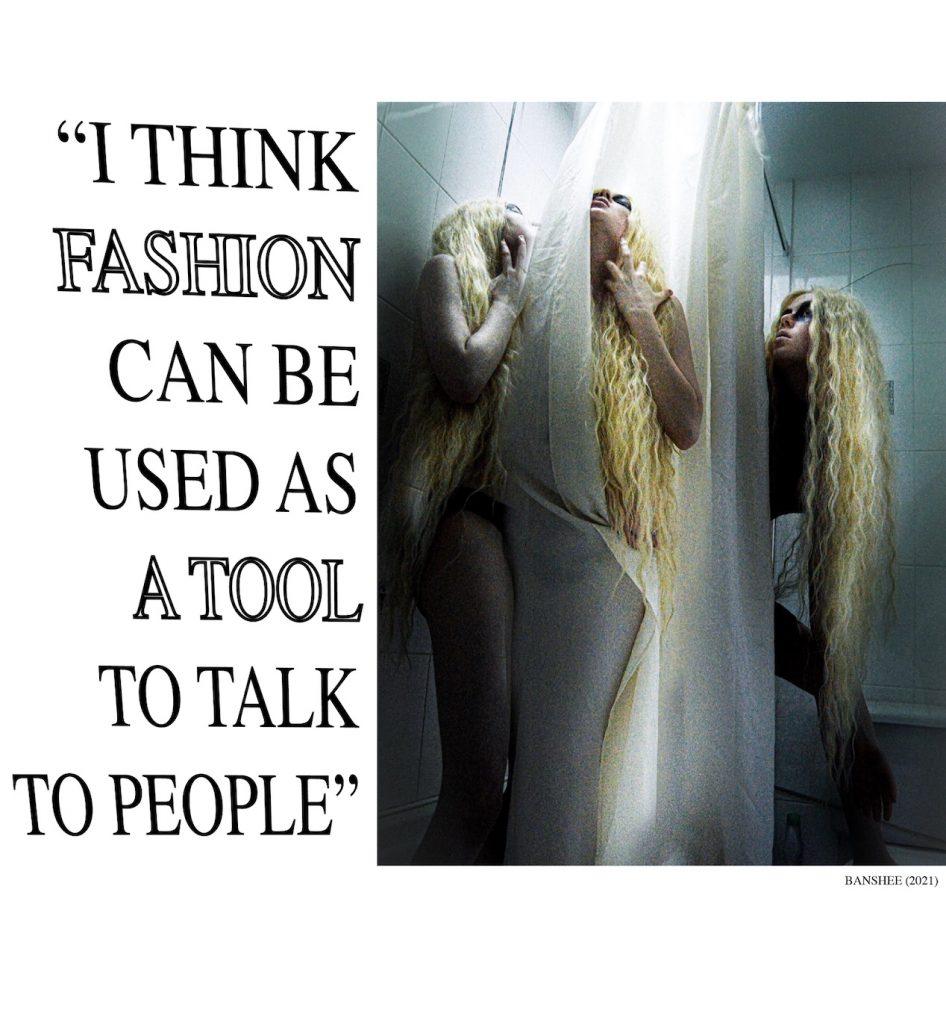
I find it really empowering because I think a lot of models, especially young models, have their images be exploited and misused, or they are not given credit where credit is due. I am really inspired by a lot of the self-portrait artists like Nadia Lee Cohen, Cindy Sherman, Juno Calypso, Isamaya Ffrench, a lot of those women who take portraits of themselves but also transform themselves into different characters so, in a sense, it’s kind of like I am the actor and the director. I have also struggled in photoshoots with other models, with how to tell them to pose, with how to communicate what I want them to do, because I don’t want to make them uncomfortable, or I want to do it in a way where I’m not confrontational. Because you don’t want to get someone to do something they don’t want to do. I try to say “okay what is effective with me?” in regards to giving direction. That’s kind of my process. But I do everything myself. I am the makeup artist, I do the styling, I do the set design… I don’t think everyone knows that all of these people on my Instagram are me. And that’s something I really wanted to convey, you know. Like, who are all these people? And is it the same person? It’s that disorientating look.
I wonder if your art normally has a political or societal commentary behind it or if some pieces are solely aesthetically driven. What is your process in coming up with these ideas and then taking them to fruition?
In high school, we had an elective that was life-changing for me. It was ‘artists as activists’. So we learned to make images based on what we were seeing in the news. We would choose a topic and then every week we got to make a piece about abortion, or gun control, or the gender wage gap. That really sparked how I learned about semiotics. A lot of it is about how I feel. I had one teacher that said ‘be really introspective and come up with four words to describe you’. So I thought about being provocative, emotive, honest, and humorous.
I have wondered about the relationship between your work and fashion? How do you feel about the interplay between fashion and it having a huge place in your photography?
I think that, since a lot of my work is character-based, everyone wears clothes, and everyone has a look. That is something I really construct. A lot of people, when they think of fashion photography they think of e-commerce or vogue, and it’s very commercialized, very glitz and glamour. It’s a certain image. It seems superficial when in reality there is a lot of work that goes into it. But I think fashion can be used as a tool to talk to people. I’m very inspired by punk and goth. I’m not a stylist that puts cute fits together, I like transforming garments. Because garments can be worn in different ways, and can say a lot of things. Personally, I think it’s sad that clothes have connotations, but when it comes to my work and styling, you can use that to your advantage. You can take those connotations and actively break them down.
How do you feel about revisiting fashion/art of the past? Are you into bringing things back and reimagining them in a different way?

Oh, of course, I think with fashion there is not much innovation – true innovation. Everything has an inspiration, everything has a reference. I think that bringing something from another time clicks with something in the psyche, something in the mind. People have seen it before, but now they’re seeing it in a new way. They think “you know I’ve seen this before”, but now something is different. That’s why I think it’s interesting, you know, revisiting period dress, especially old styles from times where women didn’t have as many rights. Or even, I watched the Paris Hilton documentary for the first time yesterday, and I think it’s so interesting how early 2000s fashion is coming back into style and we’re calling these women fashion icons, when back in their day they were slut shamed relentlessly and hounded by the paparazzi. By taking that style and giving it new meaning, it sort of feels like we’re giving these women a new story. It’s a reconciliation, in a way.
Do you find putting your work on Instagram empowering, or pressurized because people are continually consuming it?
I think it’s an interesting topic because I think anyone can use Instagram for whatever they like. I know that in the past, in going through high school, I felt I needed to project myself on Instagram a certain way. It wasn’t very healthy, you know, it was very ‘I need to look perfect, I need to look like I have friends, I need to look like this’ and I think I’ve always wanted to put my art online in case anything gets lost. When I went to art school I started posting my stuff, people started liking it, people started getting in contact with me. I do think there is artist burnout. Not everyone can post every week or produce content that is of a higher standard every week, and that is something that needs to be talked about. Another thing is with the censorship on Instagram. I know a lot of the artists I admire who display nudity or show different bodies that are not necessarily the bodily cannon or beauty standards that people value get censored.
I know that my content is not made for everyone, but it makes me happy to have this page, to share this, to have it as my portfolio. I’m honestly honored that people connect with it, because it’s very personal, and a lot of the ideas are very personal to me. So having people connect with it is really interesting to sort of start a conversation.
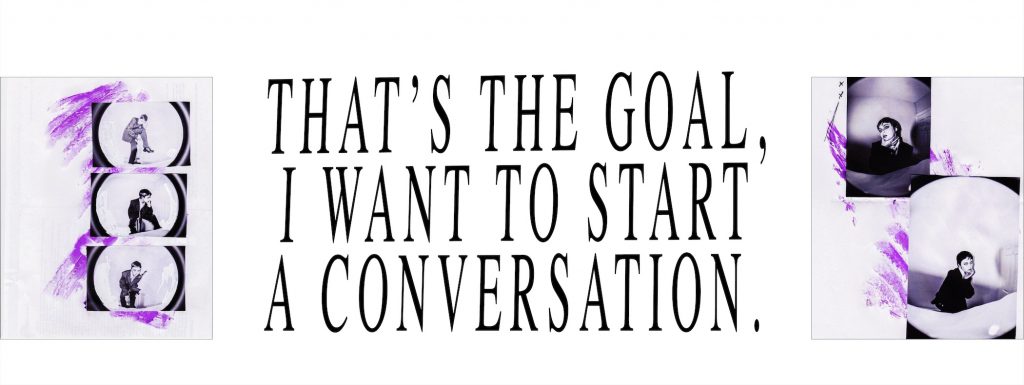
You can follow Sínead on Instagram at @sinead.aoife.
An interview by Jade Fagersten. Jade is the Co-Founder of BRIZO and is currently based in Los Angeles.

